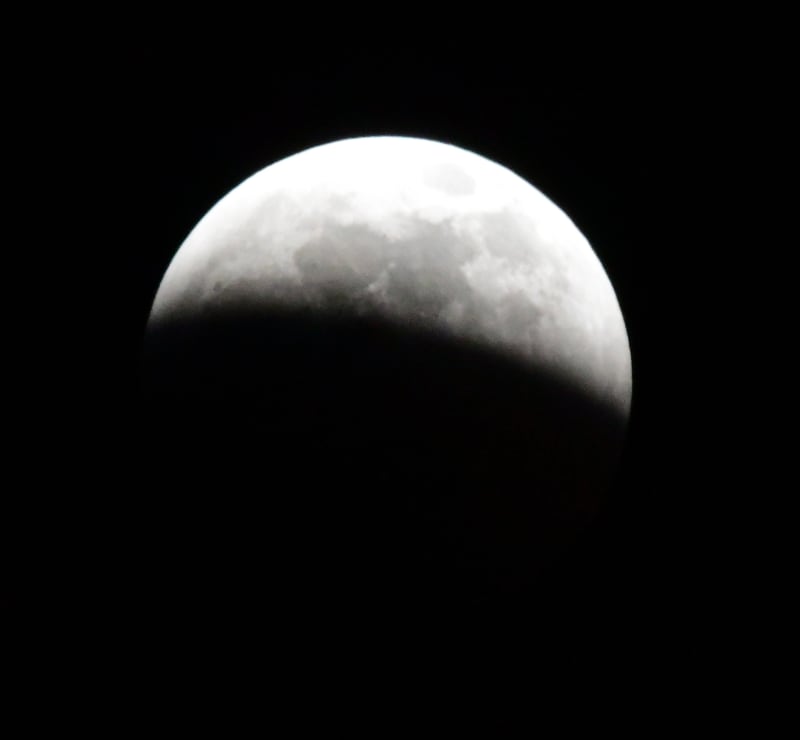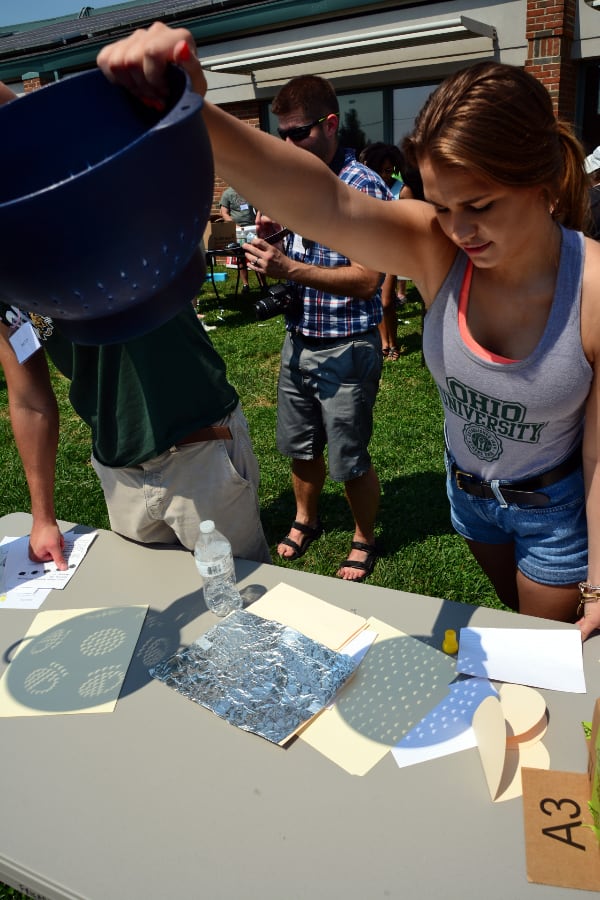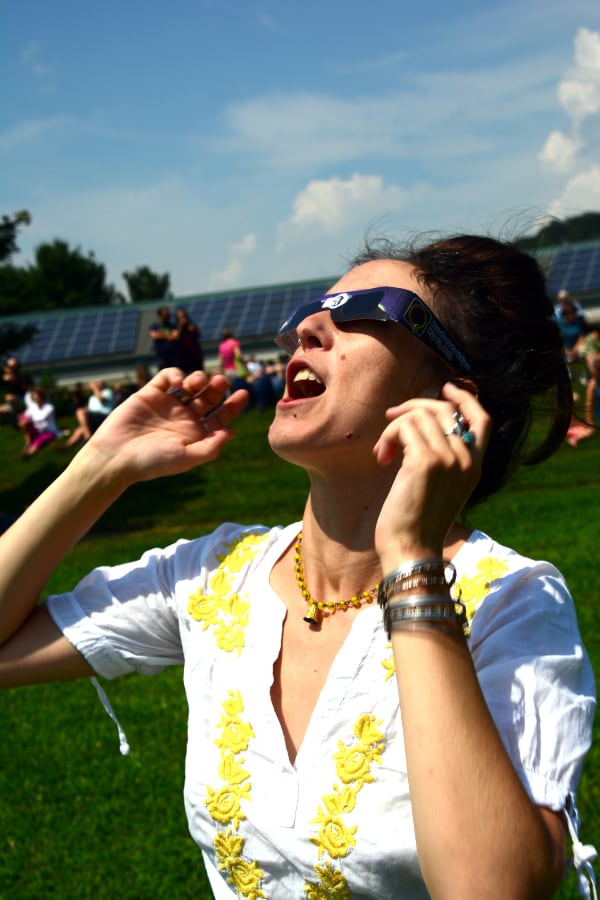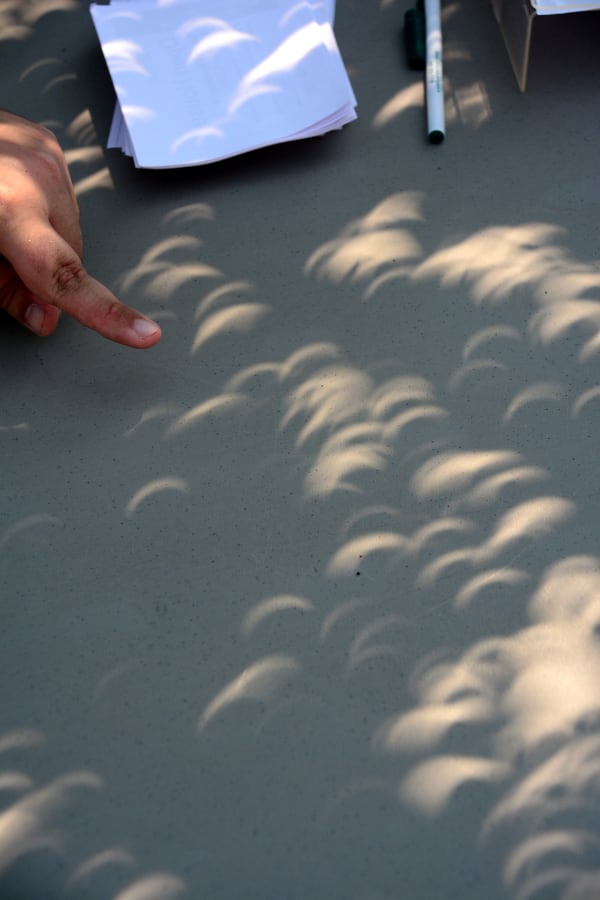
There will be a total solar eclipse in much of the U.S. on Monday. It will represent a rare occasion to watch . . . feather-headed television anchors say things even stupider than usual, which is a feat. Many people will destroy expensive cameras and others will damage their eyesight attempting respectively to capture and observe the event.
Solar eclipses — lunar ones are more interesting, I believe — are fascinating, but when I say that, it isn’t for the reasons you probably think.

As you learned if you went to school when the teaching of facts was still provided in schools, a solar eclipse takes place when the moon, orbiting the earth as it does, comes between us and the sun. (A lunar eclipse happens when the earth and the moon effectively change places, and the earth prevents the sun’s light from reaching the moon.)
From our point of view the moon seems about the same diameter as the sun, so if everything lines up just right the sun disappears for a few minutes. Because the moon’s orbit is not perfectly round, sometimes the moon is farther away, so a little rim of sun appears around it. This is called an annular eclipse. There was one of those last October. The one on Monday isn’t annular, so the whole round sun will be obscured in the relatively small area of totality. This is of scientific interest because it presents an opportunity to examine the solar corona, the vast part of the sun we can’t see most of the time. It is kind of like the sun’s atmosphere, as to location, at least. The sun has been active lately, something called “solar maximum,” so observing the corona could provide useful information.

Monday’s total eclipse, which because of the orbital mechanics of the moon in relation to the earth appears to travel from west to east, will begin off the Pacific coast of central Mexico and will head north and east through Texas, Arkansas, “Swamp East” Missouri, Illinois, Indiana, western Ohio, western New York, Vermont, some of Canada (which is already in permanent darkness, by its choice), Newfoundland, and after a while it will be over as the earth, moon, and sun go on about their normal business.
A partial eclipse of a greater or lesser degree will be visible everywhere in the continental United States.
Eclipses, people who speculate for a living speculate (they weren’t there), were seen as divine actions in ancient times. I speculate that this was true to some extent, but our early ancestors were more astronomically sophisticated than we like to admit: look at Stonehenge or the Great Pyramids. They are so astronomically precise that some other modern people, who hope to make money speculating, have offered theories that these and other structures could not have been built without the assistance of space aliens. (The Mesopotamians, it is said, installed a king then sacrificed him when there was an eclipse. My question is how, if they were as ignorant as we claim they were, they organized all this and carried it out between the beginning and end of a solar eclipse, because they couldn’t have predicted it. Also, any chance we can reschedule this year’s presidential election for sometime between now and Monday? The sun god might be hungry for something fat, loud, and orange. Or something dishonest and enfeebled.)
I have my own theories about eclipses, one of which I’ve personally observed and one of which simply stands to reason.
The first has to do, oddly, with the shape of sunlight, and includes experiments you can easily and safely do yourself.

The sun is usually a point of light. It is round. Its rays are in no special orientation. But this isn’t true during a solar eclipse. When there’s an eclipse, part of the sun is obscured, so our source of light isn’t round anymore. An effect of this is in our shadows. Here’s an experiment: go outside during the partial eclipse, turn your back to the sun, and hold out your hand in the sunlight, then revolve it, like “jazz hands.” Don’t look at your hands but at their shadow. The shadow will vary, the shadows growing sharper as your fingers are in alignment with the visible sliver of the sun. As you rotate your hands the shadows cast by your fingers will grow fatter and more indistinct or narrower and better defined. Likewise, the shape of the light on the ground produced in passing through a small round hole in something will be crescent-shaped.
If you suffer from migraine headaches, it is likely that you have noticed that variations in light can trigger them. In my experience, the change in the orientation of the light, a kind of polarization, triggers a migraine every time. Not by my looking at the eclipse, but by how the eclipse makes the world look. It isn’t that it gets darker, it’s the nature of the light itself.
There hasn’t been a lot of research on this — though there has been some — probably because it would be difficult to conduct and even more difficult to pay for: who is going to grant money for something that isn’t much of a problem (unless you get migraines) and even if it were, it would be one only when there were solar eclipses?
My other theory, which I now learn has occurred to others who seem to have proven it, has to do with eclipses and earthquakes.
Here’s why. The solid ground under our feet is like the balloon part of a water balloon. What’s inside is anything but solid. As a result, the world isn’t round. It varies in shape, like a water balloon. Because the world revolves, its diameter at the equator is greater than its diameter at the poles, the effect of centrifugal force. (Another effect is that you would weigh slightly less at the equator than you would at one of the poles, as the earth’s rotation tries in vain to fling you into space as you stand at the equator.) But there are other things that affect the shape of our planet. Two of them are the sun and the moon. They are the reason the oceans have tides. The earth’s gravity pulls on the ocean’s waters, keeping them from flying away, but so do the moon and sun.

If you follow weather forecasts near oceans, the phrase “astronomical high tide” is familiar to you. These occur at full moon, when the moon and sun are on opposite sides of the earth, and new moon, when they’re on the same side. At new moon, the astronomical tides are stronger, because the gravity of both sun and moon are aligned, pulling together on the water and, in fact, on the shape of the earth itself, making the planet a little more egg-shaped. A solar eclipse is the ultimate new moon.
As recently as yesterday we were reminded by the earthquake in Taiwan that the skin on top of our water balloon planet is fragile when you consider it on an astronomical scale. It is solid, but it is thin and still is subject to pressures. It moves around, slowly in human terms but pretty vigorously otherwise. Pieces of that skin push together and pull apart, and crack — think of our water balloon covered in dried tempera paint — and we get things like earthquakes and volcanoes. We’ve seen a lot of both lately, though they haven’t anything to do with the eclipse inasmuch as there has been no eclipse underway. They are the result of immense pressures. Wouldn’t this hit a peak under the influence of the gravity of the sun and that of the moon at the same time? Seems so to me.
It has always been my theory that we should have an increase in earthquakes during solar eclipses. Fault lines almost ready to give way or seams ready to open are given that little dab of additional motivation. But does this happen?

As it turns out, yes, by a measurable amount. The amount of increase is actually greater than I would have estimated. The link above quotes the U.S. Geological Survey as estimating that earthquakes are three times as likely to take place during an eclipse than at other times.
It takes a bit of mathematical voodoo to find it, but it’s there. As the USGS puts it, “The stresses induced in the earth by an extraterrestrial mass are proportional to the gravitational field gradient dg( r ) / dr and NOT to the gravitational field g( r ). g( r ) = GMm / r\^2 thus: dg( r ) / dr = -2 * g( r ) / r = -2GMm / r\^3” See? To put it another way, “The moon, sun, and other planets have an influence on the earth in the form of perturbations (small changes) to the gravitational field. The relative amount of influence is proportional to the objects mass, and inversely proportional to the third power of its distance from the earth.”
Even if arithmetic isn’t your favorite, you can take a more digestible look on Monday (I’d recommend Monday night — not everything is reported instantly) at the day’s earthquakes. The USGS has a web page that reports pretty much all of them. There are a lot of them, every day. Will there be increase on Monday? Look and see for yourself. As a control, go there and get a sense of it now, and in the days before and after the eclipse. On the page you can sort them by magnitude or time of occurrance. What’s more, you can do it from anywhere — don’t have to be under the eclipse.
Over the next few days you will see more and more coverage of the eclipse. You will be amazed at how very little our television personalities know about them. (Let it be a guide: they’re equally ignorant about everything else, except celebrity trivia.) Some of what is said will be true, the most important of which is DON’T LOOK DIRECTLY AT THE ECLIPSE. Do you really want to learn the Braille for “I should have listened”?
Totality will come within about a hundred miles of me, an easy drive. No, I do not intend to make the trip, though the state has set aside millions of dollars to accommodate people coming from all over to indirectly watch it, or watch it directly through trick glasses that sometimes work but not always. (Consumer tip: there will be a big sale on eclipse glasses beginning Tuesday.)
It promises to be a circus.
It is spring in the Midwest. There’s about an even chance that Monday will be cloudy.

Dennis E. Powell is crackpot-at-large at Open for Business. Powell was a reporter in New York and elsewhere before moving to Ohio, where he has (mostly) recovered. You can reach him at dep@drippingwithirony.com.
You need to be logged in if you wish to comment on this article. Sign in or sign up here.
Start the Conversation